Elsir Mohamed Osman Alkbashi1 Prof: Seif Al-Din Fattouh Osman2
Neelain University, Sudan.
Email: neneot449@gmail.com
2 Emirates College. Sudan.
HNSJ, 2022, 3(12); https://doi.org/10.53796/hnsj31215
Published at 01/12/2022 Accepted at 10/11/2022
Abstract
Proceeding from the importance of voice in practical life and its being included in many fields, we embarked on the idea of this project, which makes the computer a tool used to classify human voices and identify the speaker’s identity, whether male or female, and then identify those infected with Covid-19 disease in Sudan, and this motive is The basis on which the researcher focused all his attention to try to reduce this problem by using one of the characteristics of sound, which is (frequency.(. The main problem on which the study was based. How to identify COVID-19 disease by voice. The research aims to identify those infected with the COVID-19 virus for adult males in Sudan (Khartoum State) using the autocorrelation technique. The research relied on the sounds collected from isolation centers and Covid examination centers, and then processing this data using the automatic link technology to identify Covid disease by sound, using one of the characteristics of the sound, which is frequency. Through the research, the following results were reached: The success of the classification process for males infected with the Covid virus by voice, the system was also tested on 50 male samples, and the success rate of testing the system was 90%, while the error rate was 10%.
عنوان البحث
التعرف علي مرضي كوفيد-19 من خلال الصوت للفئة العمرية للذكور
بإستخدام تقنية الإرتباط الذاتي Auto-Correlation
السر محمد عثمان الكباشي1 بروف سيف الدين فتوح عثمان2
1 جامعة النيلين ، السودان.
البريد الإلكتروني: neneot449@gmail.com
2 كلية الإمارات. السودان.
HNSJ, 2022, 3(12); https://doi.org/10.53796/hnsj31215
تاريخ النشر: 01/12/2022م تاريخ القبول: 10/11/2022م
المستخلص
انطلاقا من أهمية الصوت في الحياة العملية وكونه مدرجا في العديد من المجالات ، شرعنا في فكرة هذا المشروع الذي يجعل الكمبيوتر أداة تستخدم لتصنيف الأصوات البشرية والتعرف على هوية المتحدث سواء ذكر أو أنثى ومن ثم التعرف على المصابين بمرض كوفيد -19 في السودان ، وهذا الدافع هو الأساس الذي ركز عليه الباحث كل اهتمامه لمحاولة الحد من هذه المشكلة باستخدام إحدى خصائص الصوت وهي (التردد) ،
والمشكلة الرئيسية التي استندت إليها الدراسة. كيفية التعرف على مرض كوفيد -19 من خلال الصوت. يهدف البحث إلى التعرف على المصابين بفيروس كوفيد -19 لفئة الذكور البالغين في السودان (ولاية الخرطوم) باستخدام تقنية الارتباط الذاتي.
اعتمد البحث على الأصوات التي تم جمعها من مراكز العزل ومراكز فحص كوفيد ، ومن ثم معالجة هذه البيانات باستخدام تقنية الارتباط التلقائي للتعرف على مرض كوفيد بالصوت ، باستخدام إحدى خصائص الصوت وهي التردد.
ومن خلال البحث تم التوصل إلى النتائج التالية: نجاح عملية التصنيف للذكور المصابين بفيروس كوفيد عن طريق الصوت ، كما تم اختبار النظام على 50 عينة ذكور ، وبلغت نسبة نجاح اختبار النظام 90٪ ، بينما بلغ كان معدل الخطأ 10٪.
1. Introduction:
The novel coronavirus disease (COVID-19) caused by severe acute respiratory syndrome coronavirus 2 (SARS-CoV-2) originated in Wuhan City, Hubei Province, China, in December 2019 (21). SARS-CoV-2 dramatically expanded worldwide and on 11 March 2020 the WHO declared the outbreak of SARS-CoV-2 a pandemic (22). The COVID-19 pandemic has become a significant global public health concern. In particular, SARS-CoV-2 has spread faster than either SARS-CoV or Middle East respiratory syndrome coronavirus because of its high binding affinity to human receptors (23). The rapid spread of SARS-CoV-2 significantly increases the burden on a country’s health-care system by raising the number of individuals seriously ill with COVID-19 and who need medical treatment (24).
The World Health Organization officially declared on January 30 that the outbreak of the virus constitutes a public health emergency of international concern, and confirmed the outbreak’s transformation into a pandemic on March 11 (37)(38)(39). Another quickly is contagious, meaning it has a dynamic structure that spreads rapidly. The main features of this disease are coughing and respiratory symptoms as well as difficulty breathing, meaning it comes in the form of colds. The World Health Organization called this disease (corona virus 2019 disease), which is in short, COVID-19.
The clinical manifestation of COVID-19 ranges from asymptomatic to severe breathing difficulties and multi-organ failure (25). As reported by the CDC, a broad range of symptoms have been observed in individuals with COVID-19, ranging from minor symptoms to serious illness. Symptoms may occur 2–14 days after exposure to the virus, including fever or chills, cough, difficulty breathing, fatigue, muscle or body aches, headache, loss of taste or smell, sore throat, nausea or vomiting, and diarrhoea (26). SARS-CoV-2 can be transmitted via respiratory droplets following coughing or sneezing by an infected individual, between people within <1 m of each other, and potentially through touching surfaces contaminated with the virus, such as telephones or doorknobs (27). No effective antiviral therapy or vaccine has yet been developed. For patients diagnosed with COVID-19, it is recommended that appropriate symptomatic treatment and respiratory support be given (28)(29). Therefore, prevention is the only way to control the outbreak of COVID-19; the best prevention strategies for the community are to minimize the incidence of exposure to the virus, including the following: use of face masks, regular handwashing with soap or hand sanitizer containing at least 60% alcohol, avoiding contact with infected people and maintaining the appropriate distance as far as possible (30). Protection from or reduction of the transmission of SARS-CoV-2 may be achieved through the identification, isolation and follow up of infected patients. In addition, environmental disinfection and personal protective equipment for medical staff are used (31).
COVID-19 continues to expand globally, according to a WHO report, as of 3 July 2020 there were 10 710 005 cases and 517 877 deaths in 188 countries and territories. In Africa, the virus was first reported in mid-February 2020, and to 3 July 2020, more than 329 796 cases have been confirmed, with 6486 deaths (32). The pandemic is speeding up – it took 98 days to reach 100 000 cases and only 19 days to progress to 200 000 cases. Ten African countries have recently shown a massive increase in the number of infected patients, making up for almost 80% of all cases in Africa. Over 70% of deaths have occurred in just five countries: Algeria, Egypt, Nigeria, South Africa and Sudan (32).
Sudan is the second largest country in Africa, with a total population of 43 849 260 (33), located in the northeastern part of Africa, neighboured by countries with a high number of COVID-19 cases, such asEgypt and the Gulf Arab countries. Before the announcement of the first case of COVID-19, the Sudan Federal Ministry of Health had strengthened the measures at entry points and, on 13 April, the government announced a partial lockdown. However, because of the weak application of these preventive measures, and the open borders of Sudan with neighbouring countries, these measures were not effective; a large number of people refused and escaped quarantine (34). To 3 July 2020, Sudan has witnessed community transmission of COVID-19, with new cases reported daily.
The first confirmed case of Corona virus was reported in Khartoum State, a man who died on March 12, 2020 who had visited the United Arab Emirates in the first week of March [35], on March 20, 2020, Sudan recorded the second infection with the Corona virus, A week after announcing the discovery of the first case of infection in the country and the death of its owner, a foreigner (whose nationality was not specified) in his forties, came to the country [36], which prompted the Sudanese government to follow after the procedures that worked to follow the quarantine policy (distancing). Social, reducing movement, curfew, reducing working hours and other measures) with the aim of limiting the epidemic and reducing injuries.
In order to adopt an accurate strategy to challenge this disease and prepare the health services against it, it was useful to pay attention to the topic of recognition such cases, because recognition models are one of the ways that help reveal a trend. And employing the other necessary resources to overcome this epidemic in an effective and timely manner, by directing all necessary interventions to mitigate the spread of this epidemic.
Recently, the importance of sound in practical life has emerged, as it enters into many fields, Including applications or areas of information security or other applications such as converting voice to written text or entering various computer commands by voice (3).As well as areas of artificial intelligence where it has many applications, whether it is general-purpose applications such as cognition and logical reasoning, or special-purpose tasks such as playing chess or medical diagnosis, experts and scientists often turn to artificial intelligence to save their experiences and experiences in which they spent their lives. The field of artificial intelligence world fit for all orientations. (2).
The researcher faced some difficulties in collecting information on the subject of the research, but, thank God, this research has been completed and produced, and he is familiar with a lot of information about the subject of research and the system has been successfully implemented and applied..
Common symptoms of the disease include fever, cough, fatigue, shortness of breath, loss of sense of smell and taste. The list of complications may include both pneumonia and acute respiratory distress syndrome the time between exposure to the virus and the onset of symptoms ranges from two to 14 days, with an average of five days, there is no vaccine yet or an effective viral treatment against the emerging corona virus, and management of the disease is limited to treating the symptoms with the provision of supportive treatment.
Preventive recommendations include washing hands, covering the mouth when coughing, maintaining an adequate distance between individuals, wearing medical face masks in public places, and monitoring and self-isolating people suspected of being infected. The response of authorities around the world has included many measures such as imposing restrictions on movement Aviation, the implementation of general closures, the definition of occupational hazard controls, and the closure of facilities, many countries have also improved their ability to conduct tests and follow-up Patient contacts.
2.PROPOSED SYSTEM AND METHODS
The paper proposed a new method, which is to Recognition those infected with the Corona virus through voice using Auto-Correlation technology, and the focus was on one of the characteristics of sound, which is frequency, where the system measures the frequency of the sound. An indication of the covid-19 disease.
A. How the Proposed Solution work
The Covid classification system has multiple stages, focusing on one of the symptoms of the disease, which is sore throat, which is considered one of the highest rates that have been reported according to the study of the World Health Organization, to know the final result by which the male voice is classified (whether he has Covid disease or not) and the result Final through the fundamental frequency of the audio or input signal.
The proposed system operates in the following stages:
- Inputs stage.
- sampling stage
- Pre-processing stage
- Classification Covid stage
B. Functional Flow Diagram
The processing of model flow blew diagram figure 3.1.
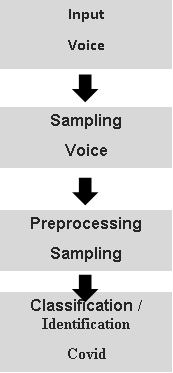
Figure 1: Shows the data flow diagram
The proposed system works in the following states:
- Inputs:
At this stage, the system takes the audio signal to be categorized by either real-time recording or by bringing a saved load sound file. There are two ways of the input process, which are as follows:
- Real-time Record method.
- the method of fetching or fetching a saved audio file.
- Samples:
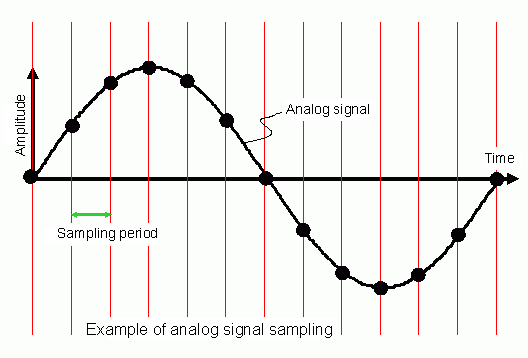 the input signal is an analog signal, it is converted the analog signal into a digital signal.
the input signal is an analog signal, it is converted the analog signal into a digital signal.
Figure 2: Show Analog of Signal Sampling
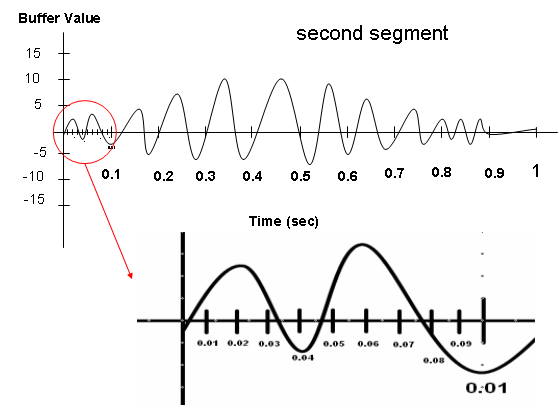
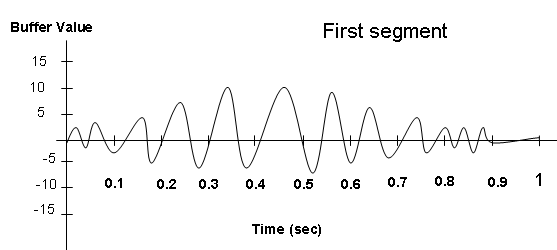 Figure 3:Show divide to samples
Figure 3:Show divide to samples
Form figure above If we take a fraction of an audio signal of 1 second and divide it by a division rate, let it be 10, we get 10 samples per second, then we divide the second into 10 fractions of a second over 10 divisions. Each of these divisions is called a sample.
From the above figure, we notice that the partition rate is small. When the audio signal is represented by the computer, the signal lacks accuracy and data loss occurs, so in order to avoid that we increase the partition rate from 10 to 100 samples per second, and thus we obtain a signal with high accuracy and avoid data loss. for a voice signal
Figure 3:Show Increase the splitting rate from 10 to 100 samples per second
- Preprocessing:
The sound is filtered from noise or distortion so that the frequency is calculated more accurately
- Classification:
This stage is considered one of the most important. At this point, the basic frequency of the audio signal is calculated, through which the process of classifying whether a person has Covid disease or not is carried out.
3.Implementation and evolution of system
We have implemented these techniques in Matlab software and the Auto-Correlation. Consequently, it is important to decide the most suitable approach to be applied. As defined before, there are several stages to perform of the COVID-19 system.
We have selected 200 samples randomly, 50 of them were classified as males by their voice who not have covid-19 and the other 150 were classified as males with COVID-19 disease from the adult category that the system aims to classify by their voices and frequencies.
The difference images are shown in below figures where classify the voices by frequencies using Auto-Correlation.
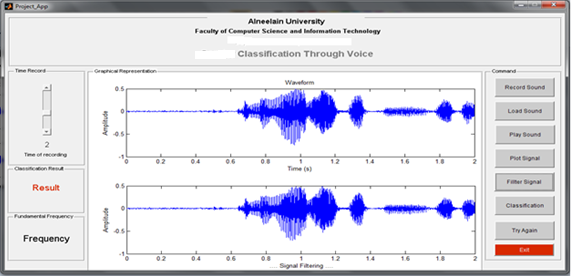
Figure 2: record sample and filtering
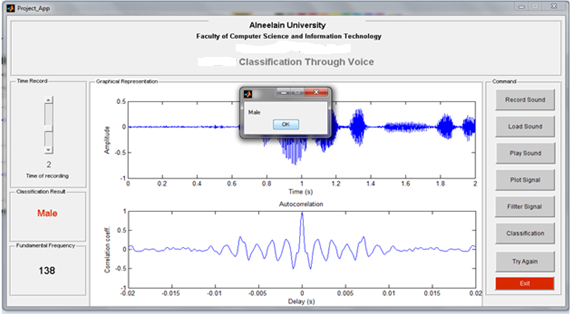
Figure 3: Classification result MALE Not have a Covid-19.
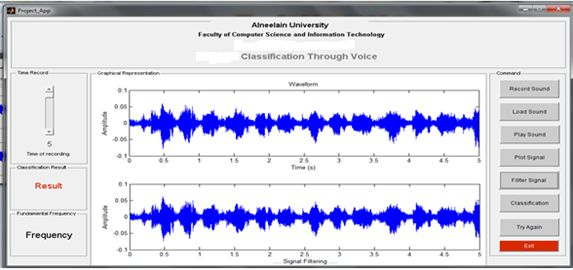
Figure 4: record sample and filtering
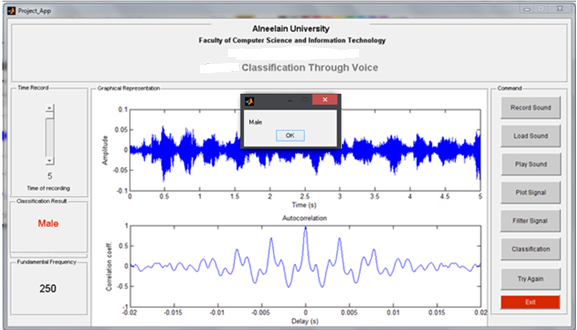
Figure 5: Classification result MALE with COVID-19.
Table 1: Some Sample diagnosed results and status.
| الحالة | نتيجة التصنيف
بمرض كوفيد-19 |
تردد العينة | التردد الطبيعي للإناث | التردد الطبيعي للذكور | الجنس | الرقم |
| True | Male | 138 | 166 – 250 Hz | 65 – 165 Hz | Male | 1 |
| True | Male | 167 | 166 – 250 Hz | 65 – 165 Hz | Male | 2 |
| True | Male | 138 | 166 – 250 Hz | 65 – 165 Hz | Male | 3 |
| True | Male | 105 | 166 – 250 Hz | 65 – 165 Hz | Male | 4 |
| True | Male | 154 | 166 – 250 Hz | 65 – 165 Hz | Male | 5 |
| True | Male | 174 | 166 – 250 Hz | 65 – 165 Hz | Male | 6 |
| True | Male | 129 | 166 – 250 Hz | 65 – 165 Hz | Male | 7 |
| True | Male | 163 | 166 – 250 Hz | 65 – 165 Hz | Male | 8 |
| True | Male | 127 | 166 – 250 Hz | 65 – 165 Hz | Male | 9 |
| True | Male | 110 | 166 – 250 Hz | 65 – 165 Hz | Male | 10 |
| False | Male- Covid | 250 | 166 – 250 Hz | 65 – 165 Hz | Male | 11 |
| True | Male | 157 | 166 – 250 Hz | 65 – 165 Hz | Male | 12 |
| True | Male | 145 | 166 – 250 Hz | 65 – 165 Hz | Male | 13 |
| False | Male-Covid | 200 | 166 – 250 Hz | 65 – 165 Hz | Male | 14 |
| True | Male Covid | 167 | 166 – 250 Hz | 65 – 165 Hz | Male | 15 |
| True | Male Covid | 250 | 166 – 250 Hz | 65 – 165 Hz | Male | 16 |
| True | Male Covid | 205 | 166 – 250 Hz | 65 – 165 Hz | Male | 17 |
| True | Male Covid | 250 | 166 – 250 Hz | 65 – 165 Hz | Male | 18 |
| True | Male Covid | 242 | 166 – 250 Hz | 65 – 165 Hz | Male | 19 |
| True | Male Covid | 235 | 166 – 250 Hz | 65 – 165 Hz | Male | 20 |
| True | Male Covid | 211 | 166 – 250 Hz | 65 – 165 Hz | Male | 21 |
| True | Male Covid | 222 | 166 – 250 Hz | 65 – 165 Hz | Male | 22 |
| True | Male Covid | 211 | 166 – 250 Hz | 65 – 165 Hz | Male | 23 |
| True | Male Covid | 222 | 166 – 250 Hz | 65 – 165 Hz | Male | 24 |
| False | Male-Covid | 235 | 166 – 250 Hz | 65 – 165 Hz | Male | 25 |
| True | Male Covid | 229 | 166 – 250 Hz | 65 – 165 Hz | Male | 26 |
| True | Male Covid | 250 | 166 – 250 Hz | 65 – 165 Hz | Male | 27 |
| True | Male Covid | 211 | 166 – 250 Hz | 65 – 165 Hz | Male | 28 |
| True | Male Covid | 229 | 166 – 250 Hz | 65 – 165 Hz | Male | 29 |
| True | Male Covid | 195 | 166 – 250 Hz | 65 – 165 Hz | Male | 30 |
| True | Male Covid | 195 | 166 – 250 Hz | 65 – 165 Hz | Male | 31 |
| True | Male Covid | 186 | 166 – 250 Hz | 65 – 165 Hz | Male | 32 |
| True | Male Covid | 169 | 166 – 250 Hz | 65 – 165 Hz | Male | 33 |
| True | Male Covid | 199 | 166 – 250 Hz | 65 – 165 Hz | Male | 34 |
| True | Male Covid | 200 | 166 – 250 Hz | 65 – 165 Hz | Male | 35 |
| True | Male Covid | 182 | 166 – 250 Hz | 65 – 165 Hz | Male | 36 |
| True | Male Covid | 171 | 166 – 250 Hz | 65 – 165 Hz | Male | 37 |
| True | Male Covid | 183 | 166 – 250 Hz | 65 – 165 Hz | Male | 38 |
| True | Male Covid | 202 | 166 – 250 Hz | 65 – 165 Hz | Male | 39 |
| True | Male Covid | 167 | 166 – 250 Hz | 65 – 165 Hz | Male | 40 |
| True | Male Covid | 244 | 166 – 250 Hz | 65 – 165 Hz | Male | 41 |
| True | Male Covid | 218 | 166 – 250 Hz | 65 – 165 Hz | Male | 42 |
| True | Male Covid | 227 | 166 – 250 Hz | 65 – 165 Hz | Male | 43 |
| True | Male Covid | 200 | 166 – 250 Hz | 65 – 165 Hz | Male | 44 |
| True | Male Covid | 209 | 166 – 250 Hz | 65 – 165 Hz | Male | 45 |
| True | Male Covid | 239 | 166 – 250 Hz | 65 – 165 Hz | Male | 46 |
| True | Male Covid | 198 | 166 – 250 Hz | 65 – 165 Hz | Male | 47 |
| True | Male Covid | 185 | 166 – 250 Hz | 65 – 165 Hz | Male | 48 |
| True | Male Covid | 215 | 166 – 250 Hz | 65 – 165 Hz | Male | 49 |
| True | Male Covid | 241 | 166 – 250 Hz | 65 – 165 Hz | Male | 50 |
| True | Male Covid | 222 | 166 – 250 Hz | 65 – 165 Hz | Male | 51 |
| True | Male Covid | 236 | 166 – 250 Hz | 65 – 165 Hz | Male | 52 |
| True | Male Covid | 187 | 166 – 250 Hz | 65 – 165 Hz | Male | 53 |
| True | Male Covid | 171 | 166 – 250 Hz | 65 – 165 Hz | Male | 54 |
| True | Male Covid | 169 | 166 – 250 Hz | 65 – 165 Hz | Male | 55 |
| True | Male Covid | 211 | 166 – 250 Hz | 65 – 165 Hz | Male | 56 |
| True | Male Covid | 214 | 166 – 250 Hz | 65 – 165 Hz | Male | 57 |
| True | Male Covid | 171 | 166 – 250 Hz | 65 – 165 Hz | Male | 58 |
| True | Male Covid | 188 | 166 – 250 Hz | 65 – 165 Hz | Male | 59 |
| True | Male Covid | 204 | 166 – 250 Hz | 65 – 165 Hz | Male | 60 |
| True | Male | 67 | 166 – 250 Hz | 65 – 165 Hz | Male | 61 |
| True | Male | 95 | 166 – 250 Hz | 65 – 165 Hz | Male | 62 |
| True | Male | 100 | 166 – 250 Hz | 65 – 165 Hz | Male | 63 |
| True | Male | 79 | 166 – 250 Hz | 65 – 165 Hz | Male | 64 |
| True | Male | 113 | 166 – 250 Hz | 65 – 165 Hz | Male | 65 |
| True | Male | 143 | 166 – 250 Hz | 65 – 165 Hz | Male | 66 |
| True | Male | 150 | 166 – 250 Hz | 65 – 165 Hz | Male | 67 |
| True | Male | 128 | 166 – 250 Hz | 65 – 165 Hz | Male | 68 |
| True | Male | 99 | 166 – 250 Hz | 65 – 165 Hz | Male | 69 |
| True | Male | 65 | 166 – 250 Hz | 65 – 165 Hz | Male | 70 |
| True | Male | 103 | 166 – 250 Hz | 65 – 165 Hz | Male | 71 |
| True | Male | 118 | 166 – 250 Hz | 65 – 165 Hz | Male | 72 |
| True | Male | 129 | 166 – 250 Hz | 65 – 165 Hz | Male | 73 |
| True | Male | 110 | 166 – 250 Hz | 65 – 165 Hz | Male | 74 |
| True | Male | 100 | 166 – 250 Hz | 65 – 165 Hz | Male | 75 |
| True | Male | 135 | 166 – 250 Hz | 65 – 165 Hz | Male | 76 |
| True | Male | 131 | 166 – 250 Hz | 65 – 165 Hz | Male | 77 |
| True | Male | 124 | 166 – 250 Hz | 65 – 165 Hz | Male | 78 |
| True | Male | 140 | 166 – 250 Hz | 65 – 165 Hz | Male | 79 |
| True | Male | 163 | 166 – 250 Hz | 65 – 165 Hz | Male | 80 |
| True | Male | 160 | 166 – 250 Hz | 65 – 165 Hz | Male | 81 |
| True | Male | 114 | 166 – 250 Hz | 65 – 165 Hz | Male | 82 |
| True | Male | 106 | 166 – 250 Hz | 65 – 165 Hz | Male | 83 |
| True | Male | 144 | 166 – 250 Hz | 65 – 165 Hz | Male | 84 |
| True | Male | 99 | 166 – 250 Hz | 65 – 165 Hz | Male | 85 |
| True | Male | 71 | 166 – 250 Hz | 65 – 165 Hz | Male | 86 |
| True | Male | 83 | 166 – 250 Hz | 65 – 165 Hz | Male | 87 |
| True | Male | 118 | 166 – 250 Hz | 65 – 165 Hz | Male | 88 |
| True | Male | 127 | 166 – 250 Hz | 65 – 165 Hz | Male | 89 |
| True | Male | 139 | 166 – 250 Hz | 65 – 165 Hz | Male | 90 |
| True | Male | 135 | 166 – 250 Hz | 65 – 165 Hz | Male | 91 |
| True | Male | 141 | 166 – 250 Hz | 65 – 165 Hz | Male | 92 |
| True | Male | 110 | 166 – 250 Hz | 65 – 165 Hz | Male | 93 |
| True | Male | 100 | 166 – 250 Hz | 65 – 165 Hz | Male | 94 |
| True | Male | 164 | 166 – 250 Hz | 65 – 165 Hz | Male | 95 |
| True | Male | 151 | 166 – 250 Hz | 65 – 165 Hz | Male | 96 |
| True | Male | 115 | 166 – 250 Hz | 65 – 165 Hz | Male | 97 |
| True | Male | 122 | 166 – 250 Hz | 65 – 165 Hz | Male | 98 |
| True | Male | 119 | 166 – 250 Hz | 65 – 165 Hz | Male | 99 |
| True | Male | 132 | 166 – 250 Hz | 65 – 165 Hz | Male | 100 |
| True | Male-Covid | 169 | 166 – 250 Hz | 65 – 165 Hz | Male | 101 |
| True | Male-Covid | 220 | 166 – 250 Hz | 65 – 165 Hz | Male | 102 |
| True | Male-Covid | 212 | 166 – 250 Hz | 65 – 165 Hz | Male | 103 |
| True | Male-Covid | 200 | 166 – 250 Hz | 65 – 165 Hz | Male | 104 |
| True | Male-Covid | 250 | 166 – 250 Hz | 65 – 165 Hz | Male | 105 |
| True | Male-Covid | 235 | 166 – 250 Hz | 65 – 165 Hz | Male | 106 |
| True | Male-Covid | 212 | 166 – 250 Hz | 65 – 165 Hz | Male | 107 |
| True | Male-covid | 221 | 166 – 250 Hz | 65 – 165 Hz | Male | 108 |
| True | Male-Covid | 205 | 166 – 250 Hz | 65 – 165 Hz | Male | 109 |
| True | Male-covid | 199 | 166 – 250 Hz | 65 – 165 Hz | Male | 110 |
| True | Male-Covid | 178 | 166 – 250 Hz | 65 – 165 Hz | Male | 111 |
| True | Male-Covid | 169 | 166 – 250 Hz | 65 – 165 Hz | Male | 112 |
| True | Male-Covid | 208 | 166 – 250 Hz | 65 – 165 Hz | Male | 113 |
| True | Male-Covid | 219 | 166 – 250 Hz | 65 – 165 Hz | Male | 114 |
| True | Male-Covid | 233 | 166 – 250 Hz | 65 – 165 Hz | Male | 115 |
| True | Male-Covid | 166 | 166 – 250 Hz | 65 – 165 Hz | Male | 116 |
| True | Male-Covid | 249 | 166 – 250 Hz | 65 – 165 Hz | Male | 117 |
| True | Male-Covid | 211 | 166 – 250 Hz | 65 – 165 Hz | Male | 118 |
| True | Male-Covid | 203 | 166 – 250 Hz | 65 – 165 Hz | Male | 119 |
| True | Male-Covid | 248 | 166 – 250 Hz | 65 – 165 Hz | Male | 120 |
| True | Male-Covid | 201 | 166 – 250 Hz | 65 – 165 Hz | Male | 121 |
| True | Male-Covid | 185 | 166 – 250 Hz | 65 – 165 Hz | Male | 122 |
| True | Male-Covid | 178 | 166 – 250 Hz | 65 – 165 Hz | Male | 123 |
| True | Male-Covid | 191 | 166 – 250 Hz | 65 – 165 Hz | Male | 124 |
| True | Male-Covid | 224 | 166 – 250 Hz | 65 – 165 Hz | Male | 125 |
| True | Male-Covid | 248 | 166 – 250 Hz | 65 – 165 Hz | Male | 126 |
| True | Male-Covid | 200 | 166 – 250 Hz | 65 – 165 Hz | Male | 127 |
| True | Male-Covid | 202 | 166 – 250 Hz | 65 – 165 Hz | Male | 128 |
| True | Male-Covid | 250 | 166 – 250 Hz | 65 – 165 Hz | Male | 129 |
| True | Male-Covid | 244 | 166 – 250 Hz | 65 – 165 Hz | Male | 130 |
| True | Male-Covid | 239 | 166 – 250 Hz | 65 – 165 Hz | Male | 131 |
| True | Male-Covid | 226 | 166 – 250 Hz | 65 – 165 Hz | Male | 132 |
| True | Male-Covid | 218 | 166 – 250 Hz | 65 – 165 Hz | Male | 133 |
| True | Male-Covid | 210 | 166 – 250 Hz | 65 – 165 Hz | Male | 134 |
| True | Male-Covid | 183 | 166 – 250 Hz | 65 – 165 Hz | Male | 135 |
| True | Male-Covid | 168 | 166 – 250 Hz | 65 – 165 Hz | Male | 136 |
| True | Male-Covid | 215 | 166 – 250 Hz | 65 – 165 Hz | Male | 137 |
| True | Male-Covid | 232 | 166 – 250 Hz | 65 – 165 Hz | Male | 138 |
| True | Male-Covid | 246 | 166 – 250 Hz | 65 – 165 Hz | Male | 139 |
| True | Male-Covid | 209 | 166 – 250 Hz | 65 – 165 Hz | Male | 140 |
| True | Male-Covid | 211 | 166 – 250 Hz | 65 – 165 Hz | Male | 141 |
| True | Male-Covid | 168 | 166 – 250 Hz | 65 – 165 Hz | Male | 142 |
| True | Male-Covid | 195 | 166 – 250 Hz | 65 – 165 Hz | Male | 143 |
| True | Male-Covid | 202 | 166 – 250 Hz | 65 – 165 Hz | Male | 144 |
| True | Male-Covid | 214 | 166 – 250 Hz | 65 – 165 Hz | Male | 145 |
| True | Male-Covid | 242 | 166 – 250 Hz | 65 – 165 Hz | Male | 146 |
| True | Male-Covid | 233 | 166 – 250 Hz | 65 – 165 Hz | Male | 147 |
| True | Male-Covid | 231 | 166 – 250 Hz | 65 – 165 Hz | Male | 148 |
| True | Male-Covid | 219 | 166 – 250 Hz | 65 – 165 Hz | Male | 149 |
| True | Male-Covid | 237 | 166 – 250 Hz | 65 – 165 Hz | Male | 150 |
| True | Male-Covid | 230 | 166 – 250 Hz | 65 – 165 Hz | Male | 151 |
| True | Male-Covid | 205 | 166 – 250 Hz | 65 – 165 Hz | Male | 152 |
| True | Male-Covid | 199 | 166 – 250 Hz | 65 – 165 Hz | Male | 153 |
| True | Male-Covid | 211 | 166 – 250 Hz | 65 – 165 Hz | Male | 154 |
| True | Male-Covid | 204 | 166 – 250 Hz | 65 – 165 Hz | Male | 155 |
| True | Male-Covid | 223 | 166 – 250 Hz | 65 – 165 Hz | Male | 156 |
| True | Male-Covid | 244 | 166 – 250 Hz | 65 – 165 Hz | Male | 157 |
| True | Male-Covid | 250 | 166 – 250 Hz | 65 – 165 Hz | Male | 158 |
| True | Male-Covid | 200 | 166 – 250 Hz | 65 – 165 Hz | Male | 159 |
| True | Male-Covid | 181 | 166 – 250 Hz | 65 – 165 Hz | Male | 16 |
| True | Male-Covid | 167 | 166 – 250 Hz | 65 – 165 Hz | Male | 161 |
| True | Male-Covid | 204 | 166 – 250 Hz | 65 – 165 Hz | Male | 162 |
| True | Male-Covid | 194 | 166 – 250 Hz | 65 – 165 Hz | Male | 163 |
| True | Male-Covid | 227 | 166 – 250 Hz | 65 – 165 Hz | Male | 164 |
| True | Male-Covid | 239 | 166 – 250 Hz | 65 – 165 Hz | Male | 165 |
| True | Male-Covid | 234 | 166 – 250 Hz | 65 – 165 Hz | Male | 166 |
| True | Male-Covid | 247 | 166 – 250 Hz | 65 – 165 Hz | Male | 167 |
| True | Male-Covid | 219 | 166 – 250 Hz | 65 – 165 Hz | Male | 168 |
| True | Male-Covid | 201 | 166 – 250 Hz | 65 – 165 Hz | Male | 169 |
| True | Male-Covid | 200 | 166 – 250 Hz | 65 – 165 Hz | Male | 170 |
| True | Male-Covid | 245 | 166 – 250 Hz | 65 – 165 Hz | Male | 171 |
| True | Male-Covid | 231 | 166 – 250 Hz | 65 – 165 Hz | Male | 172 |
| True | Male-Covid | 214 | 166 – 250 Hz | 65 – 165 Hz | Male | 17173 |
| True | Male-Covid | 221 | 166 – 250 Hz | 65 – 165 Hz | Male | 174 |
| True | Male-Covid | 206 | 166 – 250 Hz | 65 – 165 Hz | Male | 175 |
| True | Male-Covid | 175 | 166 – 250 Hz | 65 – 165 Hz | Male | 176 |
| True | Male-Covid | 187 | 166 – 250 Hz | 65 – 165 Hz | Male | 177 |
| True | Male-Covid | 193 | 166 – 250 Hz | 65 – 165 Hz | Male | 178 |
| True | Male-Covid | 211 | 166 – 250 Hz | 65 – 165 Hz | Male | 179 |
| True | Male-Covid | 222 | 166 – 250 Hz | 65 – 165 Hz | Male | 180 |
| True | Male-Covid | 210 | 166 – 250 Hz | 65 – 165 Hz | Male | 181 |
| True | Male-Covid | 169 | 166 – 250 Hz | 65 – 165 Hz | Male | 182 |
| True | Male-Covid | 237 | 166 – 250 Hz | 65 – 165 Hz | Male | 183 |
| True | Male-Covid | 220 | 166 – 250 Hz | 65 – 165 Hz | Male | 184 |
| True | Male-Covid | 231 | 166 – 250 Hz | 65 – 165 Hz | Male | 185 |
| True | Male-Covid | 177 | 166 – 250 Hz | 65 – 165 Hz | Male | 186 |
| True | Male-Covid | 169 | 166 – 250 Hz | 65 – 165 Hz | Male | 187 |
| True | Male-Covid | 209 | 166 – 250 Hz | 65 – 165 Hz | Male | 188 |
| True | Male-Covid | 234 | 166 – 250 Hz | 65 – 165 Hz | Male | 189 |
| True | Male-Covid | 212 | 166 – 250 Hz | 65 – 165 Hz | Male | 190 |
| True | Male-Covid | 216 | 166 – 250 Hz | 65 – 165 Hz | Male | 191 |
| True | Male-Covid | 199 | 166 – 250 Hz | 65 – 165 Hz | Male | 192 |
| True | Male-Covid | 167 | 166 – 250 Hz | 65 – 165 Hz | Male | 193 |
| True | Male-Covid | 185 | 166 – 250 Hz | 65 – 165 Hz | Male | 194 |
| True | Male-Covid | 224 | 166 – 250 Hz | 65 – 165 Hz | Male | 195 |
| True | Male-Covid | 249 | 166 – 250 Hz | 65 – 165 Hz | Male | 196 |
| True | Male-Covid | 250 | 166 – 250 Hz | 65 – 165 Hz | Male | 197 |
| True | Male-Covid | 200 | 166 – 250 Hz | 65 – 165 Hz | Male | 198 |
| True | Male-Covid | 211 | 166 – 250 Hz | 65 – 165 Hz | Male | 199 |
| True | Male-Covid | 234 | 166 – 250 Hz | 65 – 165 Hz | Male | 200 |
Table 2: shows frequency and percent of health and positive samples.
| Frequency | Percent | |
| Male not have a covid-19 | 50 | 43.30% |
| Male – Covid | 150 | 46.70% |
| False Percent
For Male – Covid |
3 | 6.67% |
| Total | 200 | 100% |
4. Conclusions:
In this paper study, overview and background about voise system and covid-19 were presented. The voice is helpful to to dignaosis the covid-19, to distinguish between the frequence sound of COVID‐19 positive people and that of healthy people.
The paper study is implemented the new method to diagnosis COVID-19 using Auto-Correlation system based on frequencies for voice . Because the covid-19 system has advantage over use the normal digonstic techiqe such as fever and cough digonstic technique. Therefore, the covid-19 system features of the Auto-Correlation technique will be optimized using frequencies. The proposed systems the real world needs a more efficient system to improve digonstic method in medcien filed.
In this paper, an efficient technique has been presented for diagnosis covid-19 using Auto-Correlation system based on frequencies for voice. In the experimental results, it is found that the frequencies of voice minimal changes compare with original voice was excellent without altering its quality. So, diagnosis COVID-19 using Auto-Correlation system based on frequencies for voice provides new digonstic techniqe.
5.Future work:
Some idea is provided in this paper for future work. The future work is some suggestion to improve the proposed approach to arrange the female voice, and to improve a new technique for classification.
Finally, the proposed technique is applied on male voice. To conducted the witness of the effectiveness for proposed technique on female.
6. Results:
- The success of the classification process for males infected with Covid by voice,
- the system was tested on 50 male samples, and the success rate of testing the system was 90%, while the error rate was 10%
- The system’s classification results for male COVID-19 voices are more accurate.
- The system was applied to the female category, and the results were ina.ccurate due to the sharpness of the voice in females.
- The more the recorded audio signal is free of noise and distortion, the more accurate the results will be.
- Noise, noise, and microphone quality directly affect the rating system results, leading to inaccurate results.ا
- The efficiency of the autocorrelation technique in calculating the value of the signal frequency.
7. Discussion:
Using a wide variety of human voices from the target group gives better results and better evaluation of the system, In this system, the adult male category was targeted to find out their infection with Covid, so the system recommends integrating mechanisms to be able to classify the age group of females as a whole, The system was applied to the adult male category only, as it was applied to the female category, but due to the intensity of the female voice, the results were inaccurate, Taking into account the recording of sounds in places free of noise and noise, and the use of a sensitive and high-quality microphone to capture sounds with high accuracy so that the results are more accurate.
8.References:
الهادي،محمد احمد،التعليم الالكتروني عبر شبكة الانترنت ( القاهرة،الدار المصرية اللبنانية،الطبعة الاولي ،2005م) (2)
الطويرقي طارق،تقنية القياسات الحيوية 1424م. (3)
(21). Hui D.S., Azhar E.I., Madani T.A., Ntoumi F., Kock R., Dar O. The continuing 2019-nCoV epidemic threat of novel coronaviruses to global health—the latest 2019 novel coronavirus outbreak in Wuhan, China. Int J Infect Dis. 2020;91:264–266. [PMC free article] [PubMed] [Google Scholar]
(22). Jin Y., Yang H., Ji W., Wu W., Chen S., Zhang W., Duan G. Virology, epidemiology, pathogenesis, and control of COVID-19. Viruses. 2020;12:372. [PMC free article] [PubMed] [Google Scholar]
(23). Shang J., Ye G., Shi K., Wan Y., Luo C., Aihara H. Structural basis of receptor recognition by SARS-CoV-2. Nature. 2020;581(7807):221–224. [PMC free article] [PubMed] [Google Scholar]
(24). Vellingiri B., Jayaramayya K., Iyer M., Narayanasamy A., Govindasamy V., Giridharan B. COVID-19: a promising cure for the global panic. Sci Total Environ. 2020;725:138277. [PMC free article] [PubMed] [Google Scholar]
(25). Zaim S., Chong J.H., Sankaranarayanan V., Harky A. COVID-19 and multiorgan response. Curr Problem Cardiol. 2020;45:100618. [PMC free article] [PubMed] [Google Scholar]
(26). Symptoms of coronavirus. Available from: https://www.cdc.gov/coronavirus/2019-ncov/symptoms-testing/symptoms.html.
(27). Desai A.N., Patel P. Stopping the spread of COVID19. Jama. 2020;323:1516. [PubMed] [Google Scholar].
(28). Adhikari S.P., Meng S., Wu Y.-J., Mao Y.-P., Ye R.-X., Wang Q.-Z. Epidemiology, causes, clinical manifestation and diagnosis, prevention and control of coronavirus disease (COVID-19) during the early outbreak period: a scoping review. Infect Dis Poverty. 2020;9:1–12. [PMC free article] [PubMed] [Google Scholar].
(29). Walls A.C., Park Y.-J., Tortorici M.A., Wall A., McGuire A.T., Veesler D. Structure, function, and antigenicity of the SARS-CoV-2 spike glycoprotein. Cell. 2020;181:281–292. [PMC free article] [PubMed] [Google Scholar].
(30). Trevisanuto D., Weiner G., Lakshminrusimha S., Azzimonti G., Nsubuga J.B., Velaphi S. Management of mothers and neonates in low resources setting during covid-19 pandemia. J Matern-Fetal Neonat Med. 2020:1–12. [PubMed] [Google Scholar].
(31). Chen X., Liu Y., Gong Y., Guo X., Zuo M., Li J. Perioperative management of patients infected with the novel coronavirus recommendation from the joint task force of the Chinese society of anesthesiology and the Chinese association of anesthesiologists. Anesthesiology. J Am Soc Anesthesiol. 2020;132:1307–1316. [PMC free article] [PubMed] [Google Scholar].
(32). Coronavirus disease (COVID-2019) situation reports. Available from: [www.who.int/emergencies/diseases/novel-coronavirus-2019/situation-reports/.
(33). Available from: https://www.worldometers.info/world-population/sudan-population/.
(34). Sudan: managing COVID-19 pandemic during a time of transition. Available from: https://www.arab-reform.net/publication/sudan-managing-covid-19-pandemic-during-a-time-of-transition/.
(35). Who.int. 2020. Naming the coronavirus disease (COVID-19) and the virus that causes it. [online] Available at: <https://www.who.int/emergencies/diseases/novel-coronavirus-2019/technical-guidance/naming-the-coronavirus-disease-(covid-2019)-and-the-virus-that-causes-it> [Accessed 16 May 2020].
(36). BBC News. 2020. Coronavirus confirmed as pandemic. [online] Available at: <https://web.archive.org/web/20200311185311/https://www.bbc.com/news/world-51839944> [Accessed 11 Mar 2020].
(37). Web.archive.org. 2020. Statement on the second meeting of the International Health Regulations (2005) Emergency Committee regarding the outbreak of novel coronavirus (2019-nCoV). [online] Available at: <https://web.archive.org/web/20200131005904/https://www.who.int/news-room/detail/30-01-2020-statement-on-the-second-meeting-of-the-international-health-regulations-(2005)-emergency-committee-regarding-the-outbreak-of-novel-coronavirus-(2019-ncov)> [Accessed 30 January 2020].
(38). Web.archive.org. 2020. WHO Director-General’s opening remarks at the media briefing on COVID-19 – 11 March 2020. [online] Available at: <https://web.archive.org/web/20200519064740/https://www.who.int/dg/speeches/detail/who-director-general-s-opening-remarks-at-the-media-briefing-on-covid-19—11-march-2020> [Accessed 11 March 2020].
(39). Reuters 2020. [online] Available at: <https://web.archive.org/web/20200313195947/https://www.nytimes.com/reuters/2020/03/13/business/13reuters-health-coronavirus-sudan.html> [Accessed 13 March 2020].
